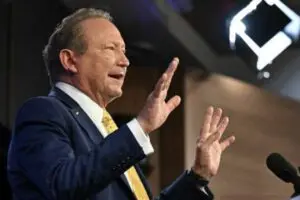Australian iron ore billionaire Andrew Forrest has warned Australia is in danger of “missing the bus” on the massive green hydrogen opportunity if it cannot match the incentives and government support provided by the US, and now the European Union.
Forrest, the chair of Fortescue Metals and Australia’s richest man, says green hydrogen is a key component of the $100 trillion green energy transition opportunity, but all the capital now is heading to the US because of Joe Biden’s Inflation Reduction Act that lowers costs and boosts returns from the new technology.
“The flight of leadership, of technology and of capital is happening from this country,” Forrest told a seminar in Sydney on Wednesday morning.
“(Australia) is replete with massive (solar) irradiance, massive wind power, everything you need. Yet that opportunity is leaving us, that bus leaving us.”
Forrest used an example his own green energy venture, Fortescue Future Industries, which has been canvassing massive opportunities in Australia for green hydrogen projects, but is now saying its first three ventures at scale will likely be in the US.
That’s because tax and production credits in the US, as part of the IRA, will provide a massive boost to returns on investment, and is already luring in capital, projects, technologies and people, and it doesn’t face the same transportation issues as the green hydrogen will be consumed in the US.
The EU is moving rapidly to match the US plan in some form, and Forrest says Australia needs to do the same, and has about a year to do that before the bus is gone.
Forrest also underlined the fact that green hydrogen, and its associated de-carbonisation opportunities, particular in hard to abate sectors, is a very big bus.
The opportunity – for thousands of gigawatts of wind and solar and green hydrogen production – would dwarf Australia’s existing big money makers, iron ore, and fossil fuels.
“Australia will miss this bus,” he said. “We are fat and happy and have a really good lifestyle. The rest of the world changing really fast, and we could miss one off opportunity if we don’t move.”

Clean Energy Council CEO Kane Thornton said Australia may have even less time to move – less than a year – and cited a recent example where one grid engineer hired by an Australian renewable developer instead rang from the airport to announce he was getting twice as much money in the US.
“The opportunity for Australia to become a green energy superpower is eye-watering,” Thornton said. “But without further policy settings we are going to have trouble to get people, capital and technology to ensure we got reliable energy system to come and lock in that extraordinary opportunity.”
The CEC says increasing and extending the Renewable Energy Target scheme would be a relatively simple and efficient approach for encouraging investors to accelerate clean energy deployment in Australia. The hydrogen industry has also released a package of six initiatives the government could take.
Pradeep Philip, the head of Deloitte Access Economics, which hosted the seminar, said Australia could leave 65 per cent of its green hydrogen export opportunities and delay the industry for a decade if it allowed the IRA to “eat Australia’s hydrogen lunch”.
“We are at a crossroads,” Philip said, noting that the IRA – and its $US200 billion a year of government support had “upended” the market, changing it irreversibly.
He was supported by Anne Valentine Andrews, the Australian head of real assets of US fund giant BlackRock Alternative Investors, whose investments include the Waratah Super Battery in NSW, the largest of its type in the world.
“The capital is moving,” she said. “The scale of opportunities is increasing exponentially.”
Forrest said the development of a green hydrogen industry was crucial for hard to abate sectors that couldn’t reduce substantial amounts through electrification, and it would support Australia’s economy and provide full employment for decades if Australia could get its share.
“You can all see it. I mean, just drive down Nullabor highway. You know, you’ll see blue sky as far as the eye I can see. You stop the car, stick your hand out and get blown off,” Forrest said.
“It’s only one part but, there’s 70,000 gigawatts right there. Many times Saudi Arabia, right in that little patch of Australia. I can take you to other parts where we can grow and grow and grow. But it can’t happen now. It literally cannot happen (if Australia does not respond to the US Inflation Act).”
State and federal energy ministers last week agreed to review the impact of the US IRA, and the measures now being taken in the EU. But there has been no public revelation about what measures could be deployed in response.










